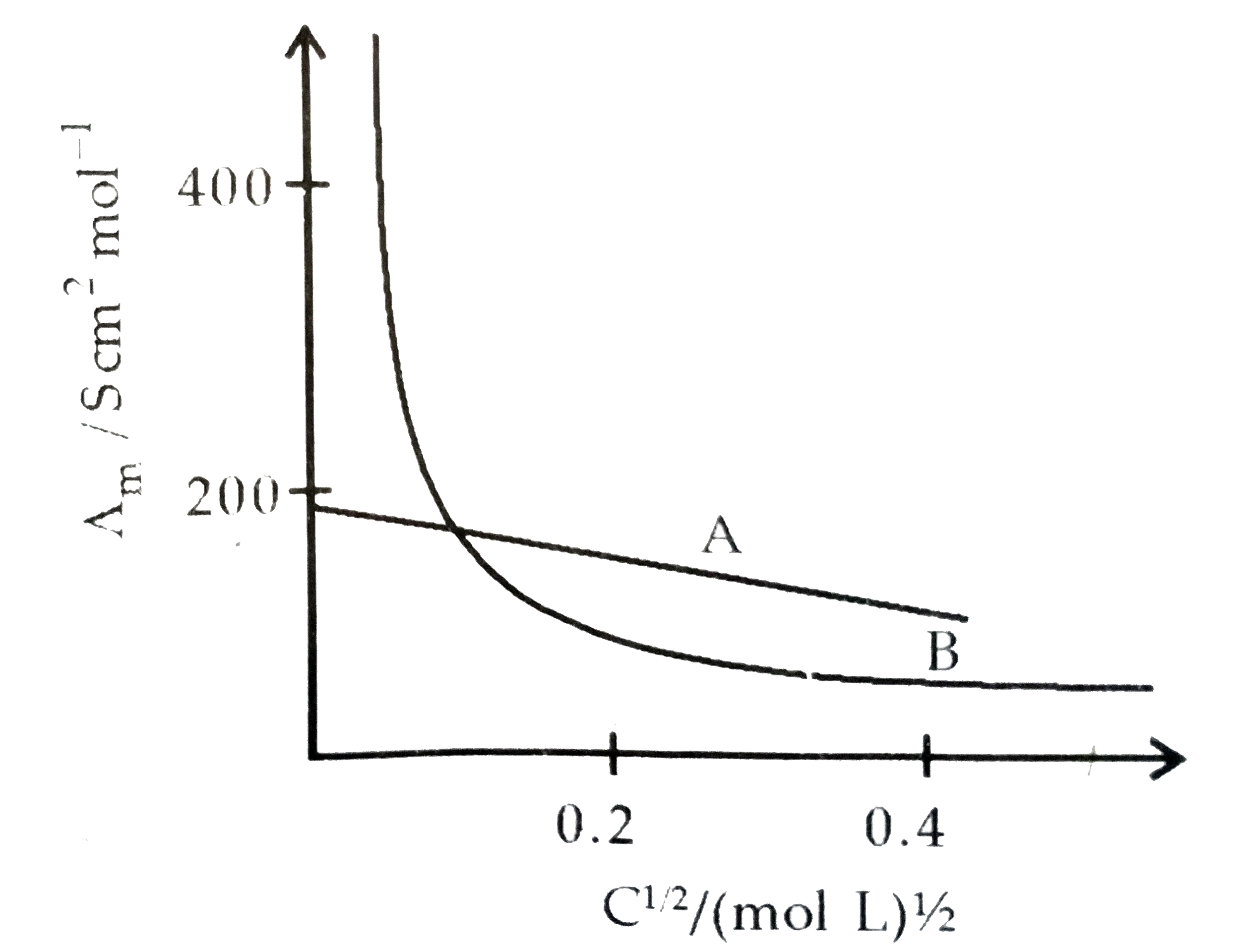Define Molar conductivity ∧m, explain its variation with dilution.
Step-by-Step Solution
Step 1: Define Molar Conductivity (λm)
Molar conductivity, denoted as λm, is defined as the conductivity of an electrolyte solution per mole of the electrolyte. It indicates how well an electrolyte conducts electricity when dissolved in a solvent. The formula for molar conductivity is given by:
λm=κ×1000C
where:
- λm = Molar conductivity (in S m²/mol)
- κ = Specific conductance (in S/m)
- C = Concentration of the solution (in mol/L)
Step 2: Explain Variation of Molar Conductivity with Dilution
When a solution is diluted, the volume of the solution increases while the number of moles of the electrolyte remains constant. For example, in a solution of sodium chloride (NaCl), both Na⁺ and Cl⁻ ions are present.
As the solution is diluted:
- The distance between the ions increases because the volume of the solution is larger.
- This increase in distance allows the ions to move more freely and reduces the interactions between them.
Step 3: Effect on Mobility and Conductivity
The increased mobility of the ions leads to an increase in the conductivity of the solution. Since molar conductivity is directly related to the mobility of the ions, it also increases with dilution.
Thus, we conclude that:
- Molar conductivity (λm) increases with dilution because the ions can move more freely, enhancing their ability to conduct electricity.
Summary
Molar conductivity (λm) is defined as the conductivity of a solution per mole of electrolyte, and it increases with dilution due to the enhanced mobility of ions in the solution.
---
Molar conductivity, denoted as λm, is defined as the conductivity of an electrolyte solution per mole of the electrolyte. It indicates how well an electrolyte conducts electricity when dissolved in a solvent. The formula for molar conductivity is given by:
- λm = Molar conductivity (in S m²/mol)
- κ = Specific conductance (in S/m)
- C = Concentration of the solution (in mol/L)
When a solution is diluted, the volume of the solution increases while the number of moles of the electrolyte remains constant. For example, in a solution of sodium chloride (NaCl), both Na⁺ and Cl⁻ ions are present.
- The distance between the ions increases because the volume of the solution is larger.
- This increase in distance allows the ions to move more freely and reduces the interactions between them.
The increased mobility of the ions leads to an increase in the conductivity of the solution. Since molar conductivity is directly related to the mobility of the ions, it also increases with dilution.
- Molar conductivity (λm) increases with dilution because the ions can move more freely, enhancing their ability to conduct electricity.
Molar conductivity (λm) is defined as the conductivity of a solution per mole of electrolyte, and it increases with dilution due to the enhanced mobility of ions in the solution.
Similar Questions
The following curve is obtained when molar conductivity (∧m) is plotted against the square root of concentration, c1/2 for two electrolytes A and B
(a) How do you account for the increase in the molar conductivity of the electrolyte A on dilution.

(b) As seen from the graph, the value of limiting molar conductivity (∧0m) for electrolyte B cannot be obtained graphically. How can this value be obtained?1
View SolutionExplain with a graph the variation of molar conductivity of a strong electrolyte with dilution.
View Solution
Knowledge Check
Molar conductivities (∧∞m) at infinite dilution of NaCl,HClandCH3COONa are 126.4,425.9and91.0Scm2mol–1 respectively. ∧∞m for CH3COOH will be:
A290.8Scm2mol–1B390.5Scm2mol–1C425.5Scm2mol–1D180.5Scm2mol–1The increase in the molar conductivity of acetic acid with dilution is due to
Adecrease in interionic forcesBincrease in degree of ionisationCincrease in self ionisation of waterDNone of the aboveStatement-1: Molar conductivity of a weak electrolyte at inifinite dilution cannot be dtermined experimentally.
Statement-2: Kohlrausch law helps to find the molar conductivity of a weak electrolyte at infinite dilution.AIf both assertion and reason are true, and reason is the true explanation of the assertionBif both assertion and reason are true, but reason is not the true explanation of the assertion.Cif assertion is true, but reason is false.DIf both assertion and reason are false.
What is the relation between molar conductivity (∧m) and equivalent conductivity (∧eq) of potash alum
[K2SO4.Al2(SO4)3.24H2O ?
View SolutionFor electrolyte AxBy which is /are not correct relation between molar conductivity (∧M) and equivalent conductivity (∧eq)
View SolutionStatement-1: Molar conductivity of a weak electrolyte at inifinite dilution cannot be dtermined experimentally.
Statement-2: Kohlrausch law helps to find the molar conductivity of a weak electrolyte at infinite dilution.
View SolutionThe increase in the value of molar conductivity of acetic acid with dilution is due to
View SolutionThe increase in the value of molar conductivity of acetic acid with dilution is due to
View Solution
